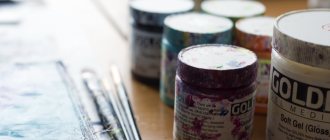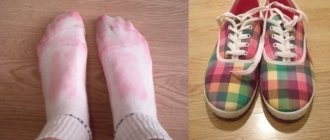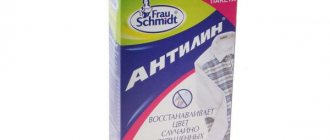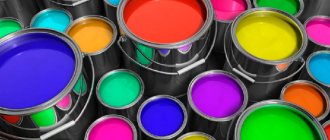When painting various surfaces with acrylic paints, it is often necessary that the composition have the desired consistency, so it is very important to choose the right thinner. If the dilution solution is chosen incorrectly, the consequences can be very sad. Incorrect proportions also impair the quality of the applied mixture.
How to dilute acrylic paint?
Acrylic composition is a type of modern water-based (water-dispersed) paints. Due to its many positive properties (environmentally friendly, reliable, quick drying), this solution is perfect for painting indoor and outdoor surfaces. Acrylic mixtures are also actively used for decoration and painting; there are special options for various materials.
In terms of consistency, a water-based acrylic solution is most often a rather thick mixture that needs to be diluted. To choose the optimal diluent, you need to pay attention to the composition. The main component that gives this group of paints its name is water; the base can make up up to 50–60% of the solution.
Thus, the solvent is water, which must meet certain requirements to obtain an ideal result:
- Temperature. To dilute the mixture, the liquid must be within 20 degrees. If façade paint is used, it is 4–5 degrees higher than the street level (minimum 15–18 o C).
- No impurities. It is recommended to use distilled water, which does not contain foreign substances. If such a composition cannot be obtained, then the liquid is first brought to a boil and settled.
Features of diluting acrylic with water
To properly dilute acrylic paints, you need to know the proportions that allow you to achieve different results:
- Ratio 1:2. If there are two parts of water to one part of the coloring mixture, then such a solution turns out to be quite liquid. It adheres well to the brush, but leaves streaks behind, so it is better to apply it with a fleecy roller. The mixture is suitable for creating a base for a base coat.
- Proportion 1:1. This composition is used to obtain the base layer. It has good viscosity and fits perfectly onto the surface. After it, a composition similar in consistency can be applied, but it is better to dilute the final layer minimally.
- A less common option is when the paint needs to be dissolved in five parts of water. This method is used by professional designers or artists when they need to tint textured elements. The composition is quickly absorbed, and the layer is barely noticeable.
What else is used to dilute paint?
Although water is the optimal solvent that is available to everyone, there are special liquids - thinners. According to their structure, they are divided into several varieties:
- Universal. Suitable for all standard compositions used to decorate walls, ceilings and facades.
Each option is used according to the recommendations provided by the manufacturer. Experimental breeding is often necessary to achieve individual results.
Features of acrylic
Acrylic paints are a type of water-based solutions. They are produced in the form of a thick consistency of various colors. In order for the solution to be applied evenly to the surface of the material, it should be diluted beforehand. Acrylic paint consists of several components:
- Dye. The pigments are various types of powder, which are crushed into very small particles. This element is made from natural or synthetic substances.
- Acrylic resin. It is used to connect all components together. It is the resin that, after drying, forms a durable film that holds the pigment on the surface of the material.
- Solvent. Many manufacturers use ordinary water for this. But some types of acrylic paints are made based on organic solvents.
- Fillers. Various substances are used here that can change the physical and decorative properties of paints. With their help, acrylic is given strength, durability or resistance to moisture.
Application of acrylic thinners
Specialized formulations are also divided according to drying speed. The correctly selected option allows you to perform work even in difficult conditions.
The following varieties are found:
- Slow. Suitable for external and internal work if temperatures are very high. The fact is that due to the rapid evaporation of ordinary water, the coating does not acquire the desired properties and may be destroyed. And slowly evaporating thinners make it possible to perform the work correctly, as a result of which the surfaces receive reliable protection.
- Average. This is a universal composition, the best option for working inside a house or apartment.
- Fast. They are used mainly outside, including at low temperatures. In such conditions, the paint, with simple dilution, does not have time to adhere to the base, and a quick thinner solves this problem.
How paints are diluted for painting
Thinning acrylic-based art paints is a more responsible process. The fact is that the volume of such compositions is small, so you cannot make a mistake with the proportion.
Dissolution is carried out using a regular pipette; it allows you to dose the amount of diluent used. Wet palettes are selected for mixing; this will eliminate the possibility of rapid drying. Getting the right consistency depends on the desired result and the job being done, but it is best to test individually.
If too thinned, add some paint or leave the mixture to dry.
Properties
The paints dry quickly and have a matte or glossy finish. They have other benefits, such as the ability to add more paint to an already painted surface. Can work on almost any basis. They do not tend to crack. Acrylic resins are made from acrylic and methacrylic acid. Using appropriate additives, a water-soluble medium is obtained that allows the pigments to be diluted with water.
Particularly important is the fact that acrylic paint dries as soon as the water evaporates. This means that more paint can be added without the risk of smudging or mixing the layers; the surface can be repainted. At the same time, the chemical structure gives the layers porosity, allowing water to completely evaporate. Research shows that the paint is resistant to oxidation and chemical degradation.
Each layer of paint adheres to the previous one, forming an almost indestructible mass.
What to do if acrylic paint has dried out?
It happens that due to improper storage at home, even in a short time, the composition manages to thicken or dry out greatly. To correct this situation, you must do the following:
- The acrylic mixture differs from simple enamels in that it can be diluted at different degrees of drying of the base composition. So, when the viscosity increases, water is simply added to the solution and mixed well. The main thing is to close the container tightly. This rule also applies to cases where there is a small residue after painting.
- If clots are observed in the composition, then add a little alcohol to the water. The mixture is thoroughly mixed until the lumps completely disappear. A small amount of solvent is poured on top and the container is well sealed.
It is more difficult to restore a dried composition. To do this, a whole set of actions is performed:
- The hardened material is removed from the container and broken into small pieces. It is important to prevent the entry of dirt and dust.
- Lumps must be crushed as much as possible. To do this, you can use a piece of pipe or fittings of suitable diameter.
- The resulting powder is poured into a convenient container and filled with well-heated water. The solution is not stirred, but shaken several times. After a minute, the liquid is drained.
- A new portion of hot liquid is added and the procedure is repeated.
- A special diluent is poured in and the mixture is stirred well until the desired viscosity is obtained. But such a material will no longer have all the properties.
If the paint has dried to a stone state, then it is better not to restore it. Although you can follow the previous procedure, which will require effort and time, the resulting composition is best used for utility rooms.
Table of contents:
Acrylic paints appeared about 50 years ago and have not lost popularity to this day. They are suitable for interior decoration, intended for painting wooden and metal surfaces, plastered walls and ceilings.
Depending on the texture of the surface and the purposes pursued, this material must be diluted. This can be done in different ways, and we will look at everything in detail.
How to dilute with water
In its original form, acrylic paint has a thick consistency, so it needs to be diluted. For this, special solvents or products recommended by the manufacturer are used.
However, you can use a simple and affordable means for dilution - water. This component is initially included in the composition, so it does not disturb the texture and makes the consistency convenient for application.
It is important to understand that the proportion of water must be strictly observed so as not to spoil the original properties. In addition, for the intended purposes you will only need clean and cool water, without additional impurities.
In painting work, four types of dilution proportions are used:
Ratio 1:1. If you add water in equal quantities to the volume of paint, you will get a consistency suitable for applying a base coat. The liquid will be thick, but will not stick to the roller or brush and will lie evenly over the surface.
Ratio 1:2. If you add two parts of water to one part of paint, you get a composition of a mobile consistency, creating a thin layer on the surface to be painted. Used on smooth surfaces to reduce the intensity of dark colors.
Ratio 1:5. If the amount of water added 5 times the volume of paint, a liquid composition is obtained - tinted water, which will penetrate between the fibers of the working tool. When applied, a barely noticeable layer is formed, which will look interesting when painting textured surfaces.
Ratio 1:15. In this case, the result is ordinary water with a small amount of dissolved dye. This composition is used to create smooth transitions between shades and gradient color designs.
Why dilute
Why, one might ask, reduce the concentration of such high-quality material? This is often necessary because the paint has been left under a loose lid for a long time, and the consistency has become too thick.
Another option is when you need more liquid paint, even to the point of tinted water. For example, to paint a textured surface, curves, hollows, and other reliefs and openwork details.
How to dilute with solvents
In 90% of cases, solvents are colorless, with a distinct specific odor. These products are used to change the texture of acrylic paints and obtain a matte or glossy surface. Unlike water, which can add “cloudiness” to the color, special thinners do not have such a negative effect.
The proportions of adding such funds depend on the type of proposed work. If there is a lot of solvent, the texture will become translucent; if there is little solvent, the thick, rich color will remain. Manufacturers give recommendations for dilution, follow them.
The use of solvents depends on the air temperature.
When painting in cold weather, use solvents with a high drying speed to ensure the paint has good adhesion to the surface.
At normal temperatures, use compounds with an average drying speed. They are considered universal and suitable for all types of work.
Slow drying solvents are designed for hot weather and prevent water from evaporating too quickly.
It is important to understand that a properly selected solvent improves the performance characteristics of the composition, affects the strength of the coating and color saturation.
Solvents that are compatible with acrylic paints:
gasoline and white spirit - compositions with a high drying rate;
kerosene – average volatility value;
turpentine - slow evaporation.
There are positive reviews about RELOCRYL ACRYL , which is designed specifically for diluting acrylic paints, varnishes and primers.
If the composition gets on a surface not intended for painting, it is washed off using a solvent remover. The composition is available in the form of a paste. It is applied to the desired area and left for 10-15 minutes . The remover dissolves the acrylic and excess is easily removed.
Regardless of the chosen option, it is important that two rules are followed - the resulting solution should not coagulate, and the presence of lumps is unacceptable.
Coloring
Acrylic paints are suitable for a wide range of surfaces and are easier to use in the early stages of a job than any traditional medium. They can be applied to almost anything. Typically acrylic is used on the following surfaces:
There is an important exception: synthetic resins do not adhere to oily substrates.
Wooden boards are a good support for acrylic. If a smooth finish is desired, it is best to sand the wood first.
Acrylic paints are great for interior painting because they dry evenly. Oils are worse on these surfaces because some colors become dull while others remain shiny and reflect light. Additionally, any lingering oil on the plaster will significantly change the color and shade. It is recommended to sand the plaster well before applying paint.
When working with brushes, special care must be taken as the paint dries quickly and becomes hard as stone. As soon as they are used, they should be rinsed thoroughly with water so that no pigment remains between the hairs. Hot water dissolves paint better.
What to do if the paint has dried
It is impossible to accurately calculate the amount of material needed, so professional builders prefer to take it in reserve. After interior finishing, there are situations when some amount of paint remains unused.
The remainder in the jar gradually dries out - the moisture evaporates over time, and polymerization begins. The more liquid “leaves”, the lower the performance characteristics of the composition.
You shouldn’t immediately throw away the damaged material: you can try to revive the paint, returning it to its original properties.
Instructions for restoring dried paint.
Grind the remains into powder with a minimum fraction.
Pour boiling water over for 2-3 seconds , then drain.
Repeat the procedure 2-3 times so that the composition warms up.
Leave the boiling water in the jar and mix the contents thoroughly until smooth.
If the paint has turned into a homogeneous plastic lump, proceed as in the previous case. But at the final stage of resuscitation, add alcohol instead of hot water. Regular women's nail polish, added a little at a time, can also help.
If finances allow, buy acrylic thinner "Gamma" . It is inexpensive, but does an excellent job with paint that has acquired a “rubber” consistency. The product is sold in online stores and specialized retail outlets.
The performance properties of the restored material will be lower than the original ones - the lumps will not completely dissolve, which will negatively affect the strength of the coating. Use this composition for painting minor surfaces that are not noticeable.
If acrylic paint has deteriorated after improper storage, for example, at subzero temperatures, it cannot be restored. In such a situation, irreversible polymerization of the material begins, various substances will be powerless.
Additional recommendations
Working with acrylic paints has nuances and secrets. Here are some of them:
The water must stand for 2-3 hours so that the impurities settle to the bottom. Only after this can it be used to dilute acrylic paints.
When applying the composition using a spray gun, work with branded solvents, adhering to the proportions recommended by the manufacturer. This way you will get a liquid of uniform consistency and achieve uniform coloring of the surface.
Rinse brushes and rollers thoroughly, especially if the work was performed with a highly diluted liquid. This composition is difficult to notice, so the particles remain between the villi. If you subsequently use paint of a lighter shade, the color will be spoiled.
Add the diluent to the composition in portions, thoroughly mixing the composition after each dose. To do this, use a special mixer.
It is not recommended to purchase the material “back to back” - it is advisable to leave a small amount of paint unused. This is necessary for spot restoration of the surface in case of accidental damage.
Coloring
Acrylic paints are suitable for a wide range of surfaces and are easier to use in the early stages of a job than any traditional medium. They can be applied to almost anything. Typically acrylic is used on the following surfaces:
There is an important exception: synthetic resins do not adhere to oily substrates.
Wooden boards are a good support for acrylic. If a smooth finish is desired, it is best to sand the wood first.
Acrylic paints are great for interior painting because they dry evenly. Oils are worse on these surfaces because some colors become dull while others remain shiny and reflect light. Additionally, any lingering oil on the plaster will significantly change the color and shade. It is recommended to sand the plaster well before applying paint.
When working with brushes, special care must be taken as the paint dries quickly and becomes hard as stone. As soon as they are used, they should be rinsed thoroughly with water so that no pigment remains between the hairs. Hot water dissolves paint better.
About thinners. How to dilute oil and acrylic paints? How to fix the pigment? (1 video)
Diluting acrylic paints with water
The basis of acrylic paints and varnishes is water, so it is advisable to use it to achieve the required consistency. An important point: you need to use only clean and cold water, standing for several hours or distilled, to prevent interaction between the components of the paint and varnish material and the thinner.
- dilution with water 1:1 - the material can be used to create a base layer, the paintwork lays down smoothly, without smudges or sagging, forming a uniform coating that effectively protects the surface from corrosion and aggressive environmental influences;
— 1:2 – the consistency is more liquid, allowing you to create a thin and even layer, the paintwork material saturates the brush or roller well;
– 1:5 – creates “colored water”, which is used to color textured details; the composition is well absorbed and fills depressions and other depressions on the surface;
— 1:15 – the proportion is not used often, it is intended to create a transition between tones (gradient); in fact, it is no longer paint, but colored water.
After applying acrylic water-based paint and varnish material, you must immediately thoroughly clean the tool used. This is explained by the fact that after drying, water-based acrylic paintwork becomes water-resistant. And, accordingly, rollers, brushes and other painting tools, once dry, cannot be cleaned.
Dilution with special acrylic thinners
Dilution with water or water with alcohol is only permissible when using a roller or brush. Paint sprayers and spray guns (painting equipment) require the use of acrylic thinners, the brand of which must be indicated by the manufacturer on the packaging. They have a specific smell and transparent appearance. The required amount of addition of such liquid depends on the scope of application, temperature and humidity of the external environment. Depending on the composition, acrylic solvents create a matte or glossy layer on the surface. Different coloring effects are achieved using a certain proportion, which is usually indicated on the thinner packaging.
Advantages of using acrylic solvent:
— accelerated drying time;
— the ability to create a matte or glossy surface;
— formation of an even layer without smudges and white deposits;
— chemical purity, compared to water;
— increased stability of paint characteristics.
Properties
The paints dry quickly and have a matte or glossy finish. They have other benefits, such as the ability to add more paint to an already painted surface. Can work on almost any basis. They do not tend to crack. Acrylic resins are made from acrylic and methacrylic acid. Using appropriate additives, a water-soluble medium is obtained that allows the pigments to be diluted with water.
Particularly important is the fact that acrylic paint dries as soon as the water evaporates. This means that more paint can be added without the risk of smudging or mixing the layers; the surface can be repainted. At the same time, the chemical structure gives the layers porosity, allowing water to completely evaporate. Research shows that the paint is resistant to oxidation and chemical degradation.
Each layer of paint adheres to the previous one, forming an almost indestructible mass.











